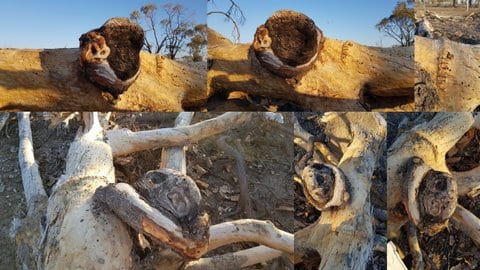This goes with that goes with this goes with that ….The more bizarre the culturally modified tree the more curious I am. If you have stone axe marks (axtrax) on the heartwood or a ‘Ring’ in the main trunk you have a CMT.

This remarkable example of a Whitewood tree (Atalaya hemiglauca) shown in the collage looks as if a small flying saucer has lodged itself in the trunk. The alien looking branch burl resembles ET’s head from some angles but the prominent axtrax points to its indigenous conception. Unfortunately this tree was cleared for a recent fence line and used to look like this:

The good news is Allan & I have had some expert advice and think we can age this tree by cutting slices or ‘biscuits’ out of the trunk and counting the rings. Failing that there is radiocarbon dating. We would like to thank Dr Jonathan Palmer Research Ass. from the school of Biological, Earth & Environmental Sciences (BEES) UNSW and Dr Paul Forster Principal Botanist & Austrobaileya editor Qld Herbarium Dept of Environment & Science. The even better news is if you think you can handle it is the possible visit by Dr Judith H Field, Honorary Senior Lecturer BEES UNSW who we know from her work at Cuddie Springs re megafauna demise, climate change and the overlap with indigenous history.
So anyway back to the ‘thing’ on the side of the Whitewood tree. There is a lack of other scartrees in the vicinity and no obvious artefacts around. In general CMTs are a ‘this goes with that goes with this goes with that’ phenomena. Campfire burn scars are mostly found in groups as the extended family or clan travelled together and built their fireplaces up against a leaning tree trunk to protect the ashes. Walgett has an average of 55 rainy days a year (believe it or not ??) so this was necessary on cold wet trips. Scarred trees are more often found together too and clustered near natural water sources. If the water was totally reliable, like at native wells on the old paleo river system there are also artefacts & evidence of stone working. With all the erosion happening in this latest drought, ovens and scattered clay balls galore are resurfacing in places not noticed before.

The idea of Ring trees & other manipulated types as intergenerational constructs is not difficult to get your head around. To quote Bill Gammage -The Biggest Estate on Earth – who quotes E J Eyre “Another very great advantage on the part of the natives is, the intimate knowledge they have of every nook and corner of the country they inhabit; does a shower of rain fall, they know the very rock where a little water is most likely to be collected, the very hole where it is the longest retained ….” . Again – James Dawson from western Vic. wrote in 1881, “In northwest Australia no tribe used another’s land except by invitation. Each has its own district in which it reigns supreme; such district is again subdivided into portions belonging to the individuals of that tribe, the children inherit and females share equally with the males in the distribution of landed property”
I reckon the maintenance of ‘rings’ & ‘things’ would have been very important to both the locals and other language groups, becoming part of the dreaming tracks. Like navigational aids these trees and the night sky helped people travel to places unfamiliar for ceremony. Here the obvious gathering spot would be the Narran Lakes which in 1999 made the list of wetlands of international importance. Like the average of 55 wet days a year for Walgett (Plants of Western NSW G.M.Cunningham et al) the idea that the Narran Lakes regularly had water is hard to credit right now when the only visitors are Archaeologists & Rangers. I’ve been told that this failed Murrumanaarr river system became a right of way and a kind of no man’s land so travellers could cross unmolested on their way to the Lakes. If so there is probably a series of altered, Ring and Marker trees pointing the way given our lack of geographical landmarks. It’s not until you get to the Ridges that the topography changes. Baiame willing and the help of Google Earth we may be able to plot these ‘arboreal aberrations’ . Firstly we have to learn how to operate the App!!!
